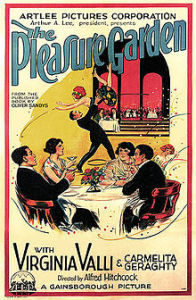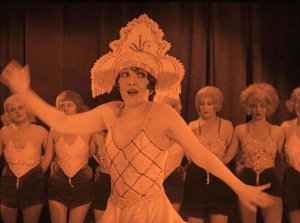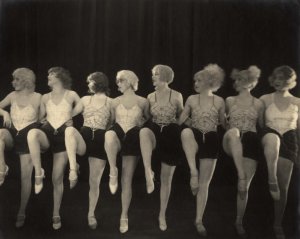The Pleasure Garden *** (1925, Virginia Valli, Carmelita Geraghty, Miles Mander, John Stuart) – Classic Movie Review 2104
In June 2013, nine restored versions of Alfred Hitchcock’s early silent films, including his 1925 first completed film as director, The Pleasure Garden, were shown at the Brooklyn Academy of Music’s Harvey Theatre. Known as The Hitchcock 9, the travelling tribute was made possible by a $3million programme organised by the British Film Institute. As a result, 20 minutes of improved footage was added to The Pleasure Garden, along with the atmospheric colour tinting of the period. The restored version runs 92 minutes.
Hitchcock’s first directing project came in 1922 with Number 13, which was cancelled because of financial problems, and the few scenes filmed in London are lost. In 1925, producer Michael Balcon gave Hitchcock another opportunity as director with The Pleasure Garden, a co-production of the London studio Gainsborough Pictures and the German firm Emelka, which he made at the Geiselgasteig studio near Munich, Germany, in the summer of 1925.
This silent movie is one of ten that Hitchcock made before he helmed Britain’s first talkie Blackmail in 1929. His début completed feature should have propelled Hitchcock’s directorial career, but the film was a commercial flop. (Next, Hitchcock directed a drama called The Mountain Eagle, which is lost.)
Eliot Stannard writes the script based on the novel by Oliver Sandys, and Hitchcock’s future wife Alma Reville is the script girl. The story focuses on the love lives of two chorus girls (Virginia Valli as Patsy Brand and Carmelita Geraghty as Jill Cheyne) at The Pleasure Garden Theatre in London.
Patsy (Valli) marries Miles Mander as Levet, a British Empire service co-worker of John Stuart as adventurer Hugh Fielding, who is the fiancé of the flighty Jill (Geraghty). But when Patsy arrives in the colonies she finds her new husband is having the time of his life with the local ladies. And after Jill gets engaged to Hugh, he travels out of the country and she begins to fool around.
Hitchcock’s tyro movie is a heavy handed and lumpily plotted historical curio that, for all its faults, is majorly intriguing for film buffs as it shows off some of the director’s themes and obsessions in embryo form. ‘Melodramatic, but there were several interesting scenes in it,’ said Hitch.
Balcon only allowed Hitchcock to direct the film after Graham Cutts, a jealous executive at Gainsborough Pictures, refused to let Hitchcock work on his film The Rat.
Hitchcock and Alma Reville became engaged during the shoot. They married at the Brompton Oratory in South Kensington, London, on 2 December 1926. Alma was to become Hitchcock’s closest collaborator, but Hitchcock would discuss only in private her contributions to his films (some of which were credited on screen) since, unlike him, she was keen to avoid public attention. Their only child Patricia was born on 7 July 1928.
© Derek Winnert 2015 Classic Movie Review 2104
Check out more reviews on http://derekwinnert.com/









